
The Solar-Terrestrial Centre of Excellence (STCE) is a collaborative network of the Belgian Institute for Space Aeronomy, the Royal Observatory of Belgium and the Royal Meteorological Institute of Belgium.
 |
Published by the STCE - this issue : 3 Jul 2015. The Solar-Terrestrial Centre of Excellence (STCE) is a collaborative network of the Belgian Institute for Space Aeronomy, the Royal Observatory of Belgium and the Royal Meteorological Institute of Belgium. |
| Archive of the newsletters | Subscribe to this newsletter by mail |
A challenging transition
On July 1st 2015, the World Data Center SILSO lays an unprecedented milestone in the long history of the Sunspot Number.
By its longevity, this reference sunspot record remains our unique direct reference retracing solar activity over more than 4 centuries and it is definitely the most widely used solar data set (more than 100 publications per year). However, this series was left unchanged since its creation by Rudolph Wolf in 1849, without any backward verification. The only innovation came in 1998 with the creation of a new similar sunspot index, the Group Number (Hoyt and Schatten 1998). However, the two parallel series showed strong differences hinting at strong inhomogeneities in either series or both. Since 2011, a group of 40 experts finally undertook a full revision of those two series in order to identify and fix the defects. This huge work was co-organized by E. Cliver (NSO, Sacramento Peak Observatory), F. Clette (WDC-SILSO, STCE) and L. Svalgaard (Stanford University) around four successive workshops (one of them held at the Royal Observatory in Brussels in 2012. See picture underneath)

Now finally, all corrections have been finalized (for a recent synthesis, see Clette et al. 2014, Space Science Reviews). Over the last few months, all corrections obtained separately, often by different scientists, were finally assembled into a final end-to-end reconstruction of the Sunspot and Group Numbers.
The figure below illustrates the change between the original and new Sunspot Number series. The most notable correction is a lowering by about 18% of all numbers after 1947, to remove the bias produced by a new counting method started in 1947 in Zürich. A large variable drift affecting the "Brussels-Locarno" Sunspot Number since 1981 has also been eliminated.
Note that for the new Sunspot Number, the 0.6 conventional Zürich factor is not used anymore, which raises significantly the scale of the entire series. This simply reflects the choice of modern counts by A. Wolfer, Wolf's successor, as new reference. The new numbers thus now match much more closely the raw Wolf numbers obtained by all observers since 1993 until today.
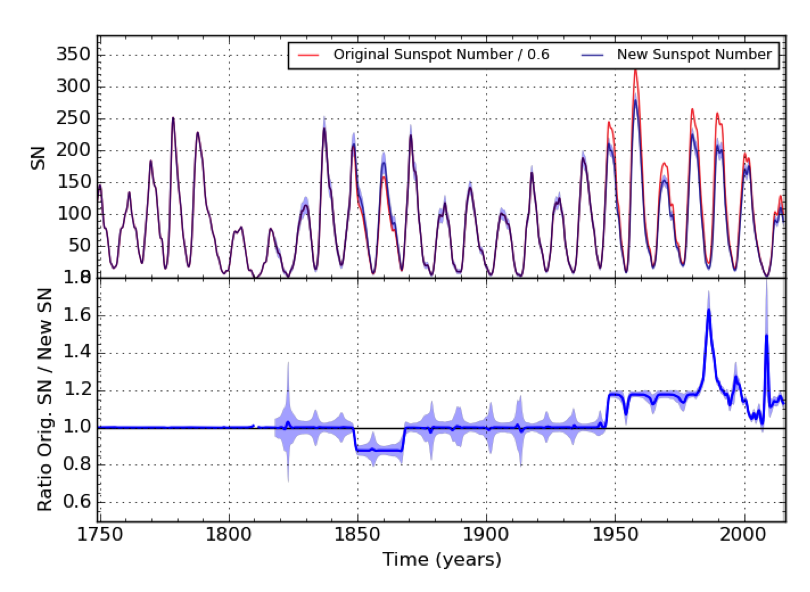
Independently, the Group Number was corrected for a large underestimate of all values before the 20th century (see figure below), due the instability of the reference data used by Hoyt and Schatten: namely the photographic data from the Royal Greenwich Observatory. As a comprehensive database of all past group counts could be constructed, the new Group Number actually consists in a fully reconstructed series rather than a correction applied to original numbers.
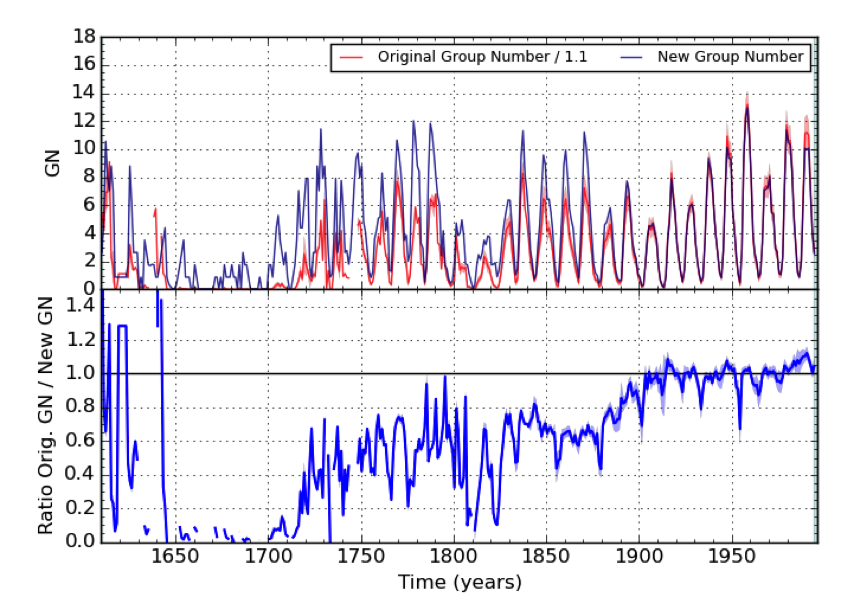
Now, finally, we can bring those two series together and observe the impact of the corrections on the original disagreements. The two following figures show how the large disagreements characterizing the initial Sunspot Number and Group number series have now been strongly reduced. We must stress here that this improvement was not obtained by an ad-hoc mutual scaling between the series. On the contrary, as corrections were determined separately based on widely different data sets and techniques, the final agreement brings an additional confirmation of the validity of those corrections.
Still, as can be seen, significant deviations remain, mainly before 1825, when the observations become scarce and in periods of activity minima (low counts). So, more work definitely remains to be done for many years to come, but given the major improvements harvested at this stage, the WDC - SILSO is now going to proceed with the public release of this new version.
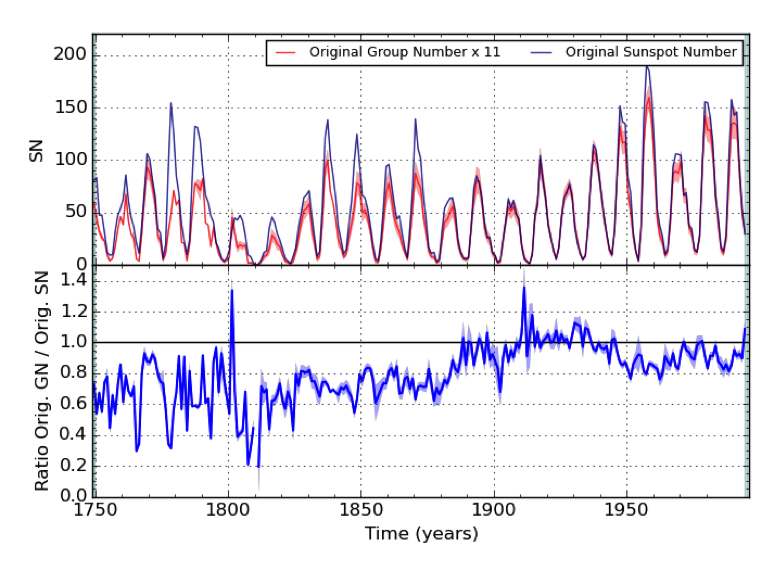
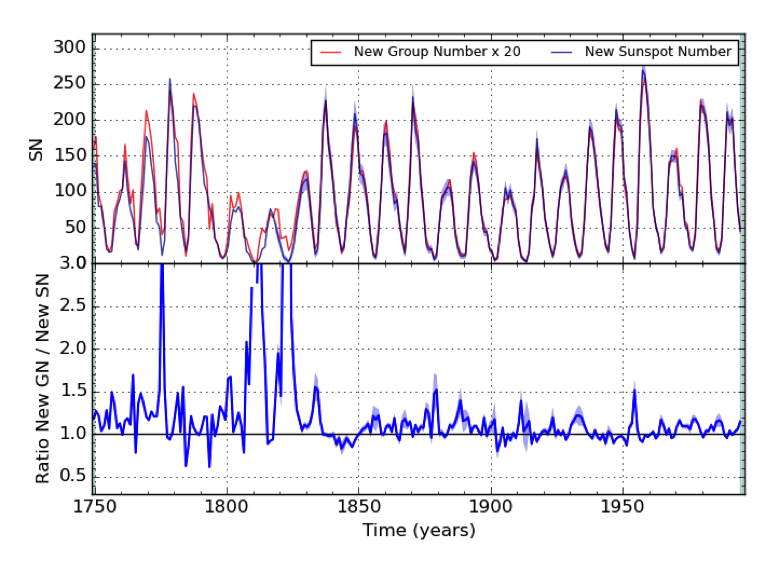
The preparation of this major operation is now almost completed. It required a huge organizational and programming work from the small SILSO team. Indeed, the release of the new past Sunspot series is just a starting point for the WDC-SILSO. Indeed, it requires a deep reworking of the operational software that will process the data from our worldwide network on July 1st and in the future. Indeed, various data products must be made seamlessly compatible with the new base total Sunspot Number series: the hemispheric Sunspot Numbers, the daily Estimated Sunspot Number, the 12-month solar-cycle forecasts, all data plots and the derivation of personal k coefficients for all stations of the network.
Moreover, as we now want to integrate a structured management of future versions of the Sunspot Number (under supervision of the International Astronomical Union), we had also to re-design the data section of our SILSO Web site. In parallel, we are also working on a thematic issue of the Solar Physics journal that will be entirely dedicated to the recalibration of the Sunspot Number (open to papers until the end of October 2015, in view of a publication in early 2016) and will fully document the present change.
The last few weeks and last few days were thus particularly hectic for the SILSO team. We will do our best efforts to accomplish this major transition on July 1st with minimal disturbances for our users. However, given the number of simultaneous changes, the processing will probably be slower than usual to allow careful verifications. We thus ask our many users to be more patient on this occasion. As problems can never be excluded, we welcome any feedback about undetected issues.
After a rather uneventful life over the past 166 years, the Sunspot Number will thus be reborn in a new incarnation on Wednesday July 1st. We hope that the science community will welcome this revived data set and will appreciate the considerable community effort accomplished over the past four years to produce a better reference for long-term solar and Sun-Earth studies.

Daily Estimated International Sunspot Number (EISN, red curve with shaded error) derived by a simplified method from real-time data from the worldwide SILSO network. It extends the official Sunspot Number from the full processing of the preceding month (green line). The plot shows the last 30 days (~ one solar rotation). The horizontal blue line shows the current monthly average, while the green dots give the number of stations included in the calculation of the EISN for each day.
On this occasion, you may also draw the attention on the change of scale, which since July 1st 2015 follows the re-calibrated sunspot series starting in 1700 (increase by about 42%).
Solar flare activity fluctuated between low and moderate during the week.
In order to view the activity of this week in more detail, we suggest to go to the following website from which all the daily (normal and difference) movies can be accessed:
http://proba2.oma.be/ssa
This page also lists the recorded flaring events.
A weekly overview movie can be found here (SWAP week 274).
http://proba2.oma.be/swap/data/mpg/movies/weekly_movies/weekly_movie_2015_06_22.mp4
Details about some of this week’s events, can be found further below.
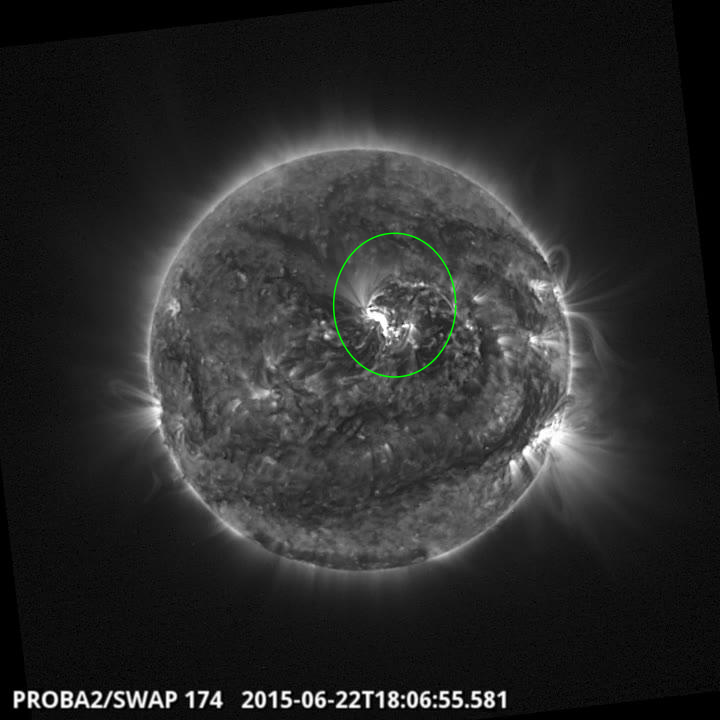
Eruption on the centre of the Sun @ 18:06 SWAP image
Find a movie of the events here (SWAP movie)
http://proba2.oma.be/swap/data/mpg/movies/20150622_swap_movie.mp4
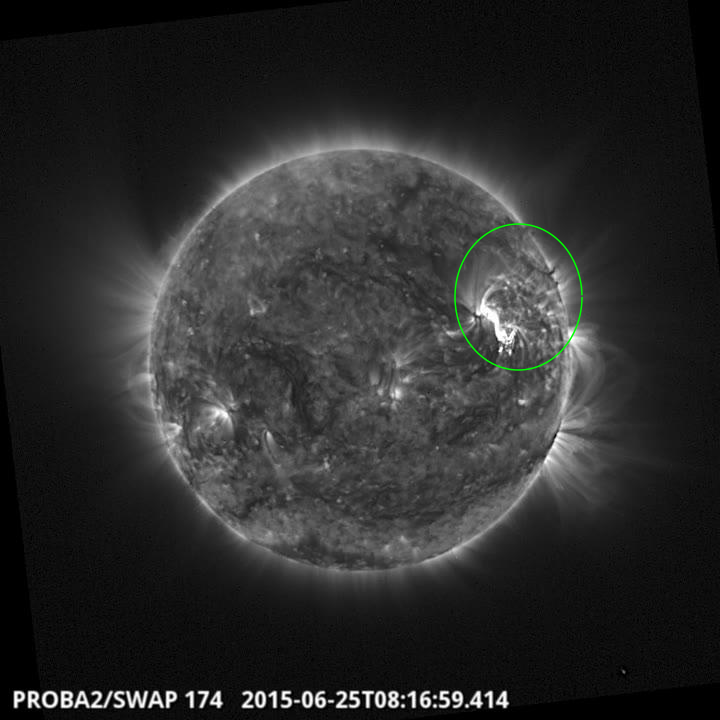
Eruption on the north west quad @ 08:16 SWAP image
Find a movie of the event here (SWAP movie)
http://proba2.oma.be/swap/data/mpg/movies/20150625_swap_movie.mp4
Solar activity was dominated by NOAA AR 2371 that produced two M-class flares related to two CMEs.
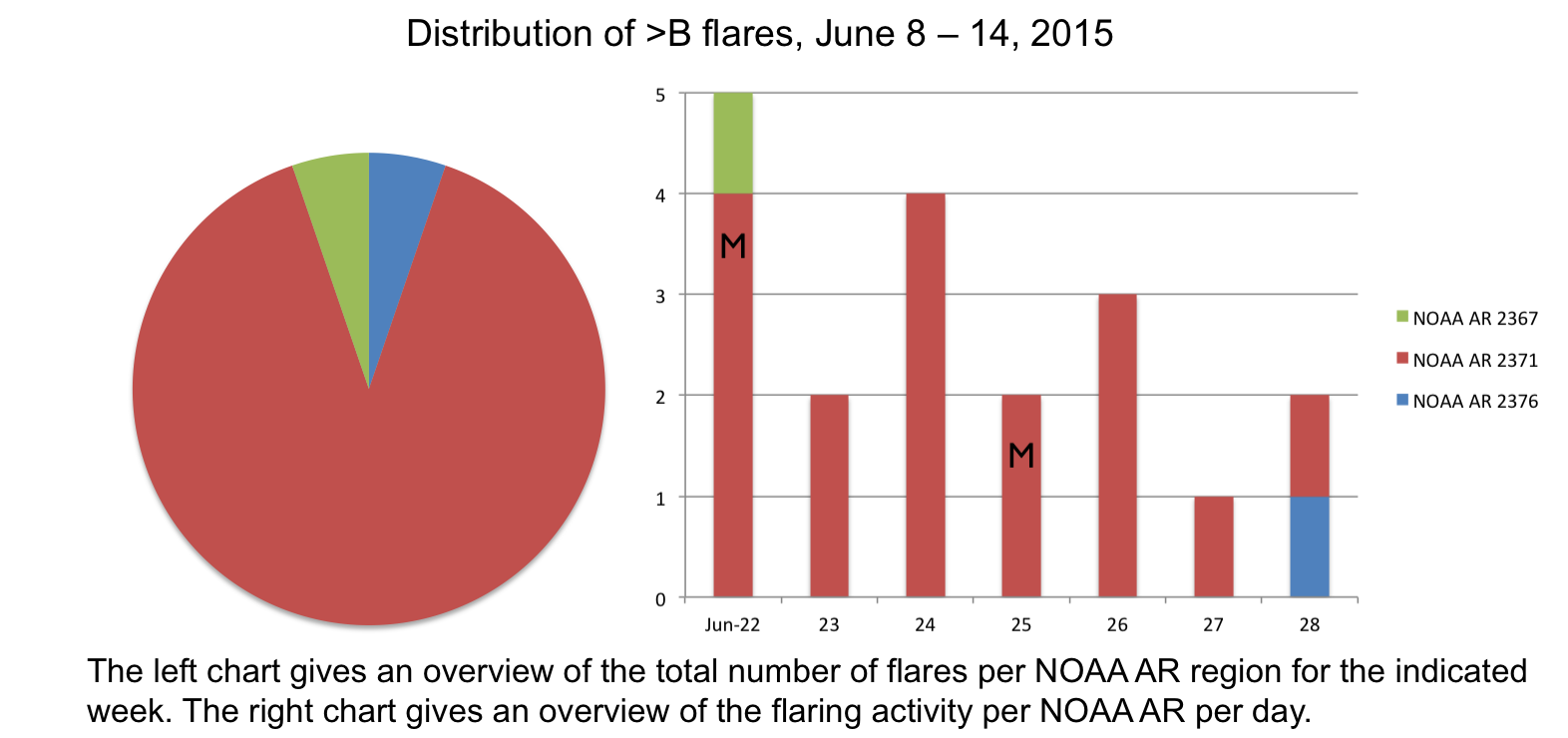
NOAA AR 2371 rotated over the west limb by the end of the week and it had already decayed before in size and complexity. On June 22 it produced an M6.5 flare peaking at 18:23 UT, related to a full halo CME (speed 1000 km/s) directed towards Earth.
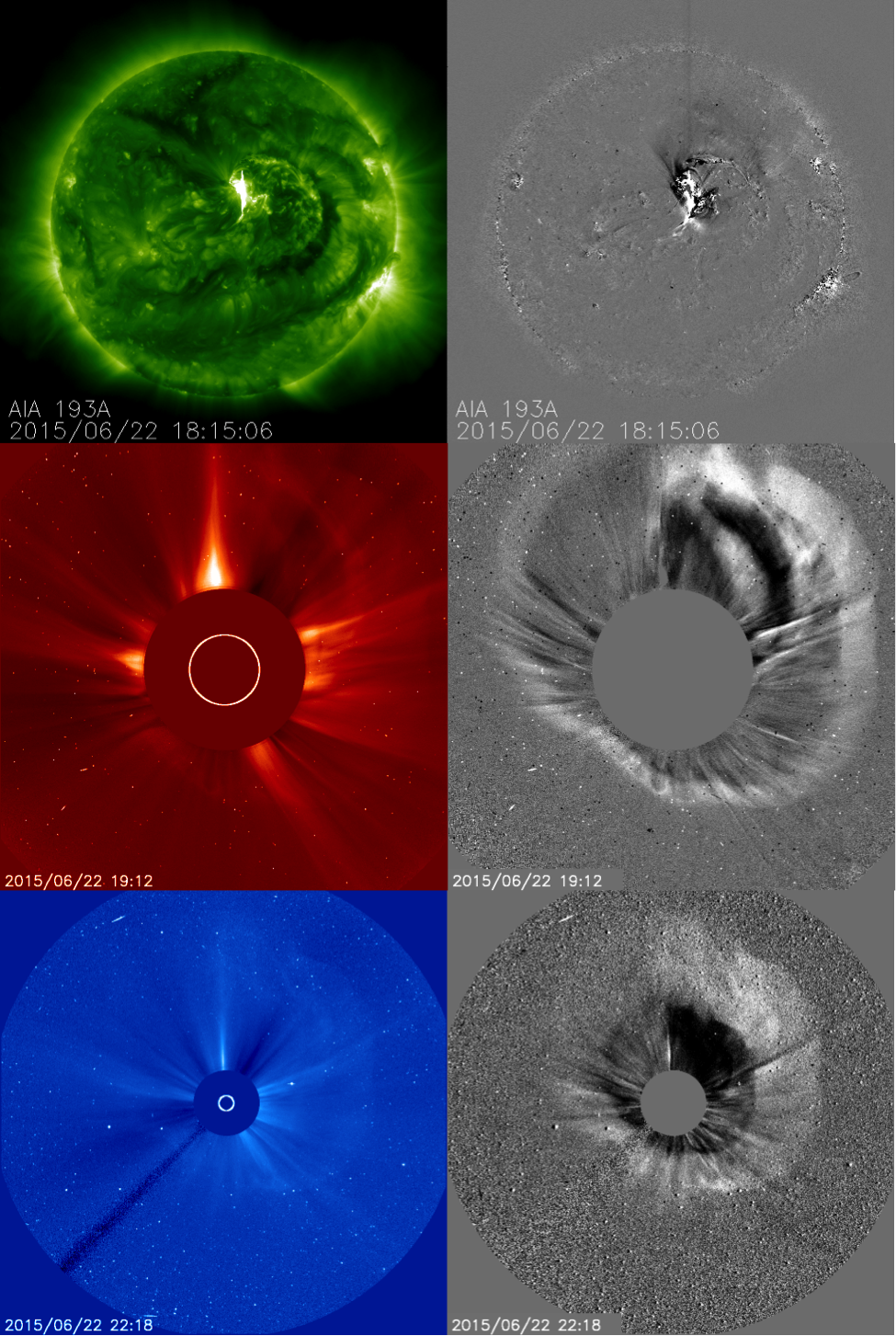
Then on June 25 NOAA AR 2371 produced an M7.9 flare peaking at 08:16 UT, again related to a full halo CME (speed 1600 km/s), with an Earth directed component.
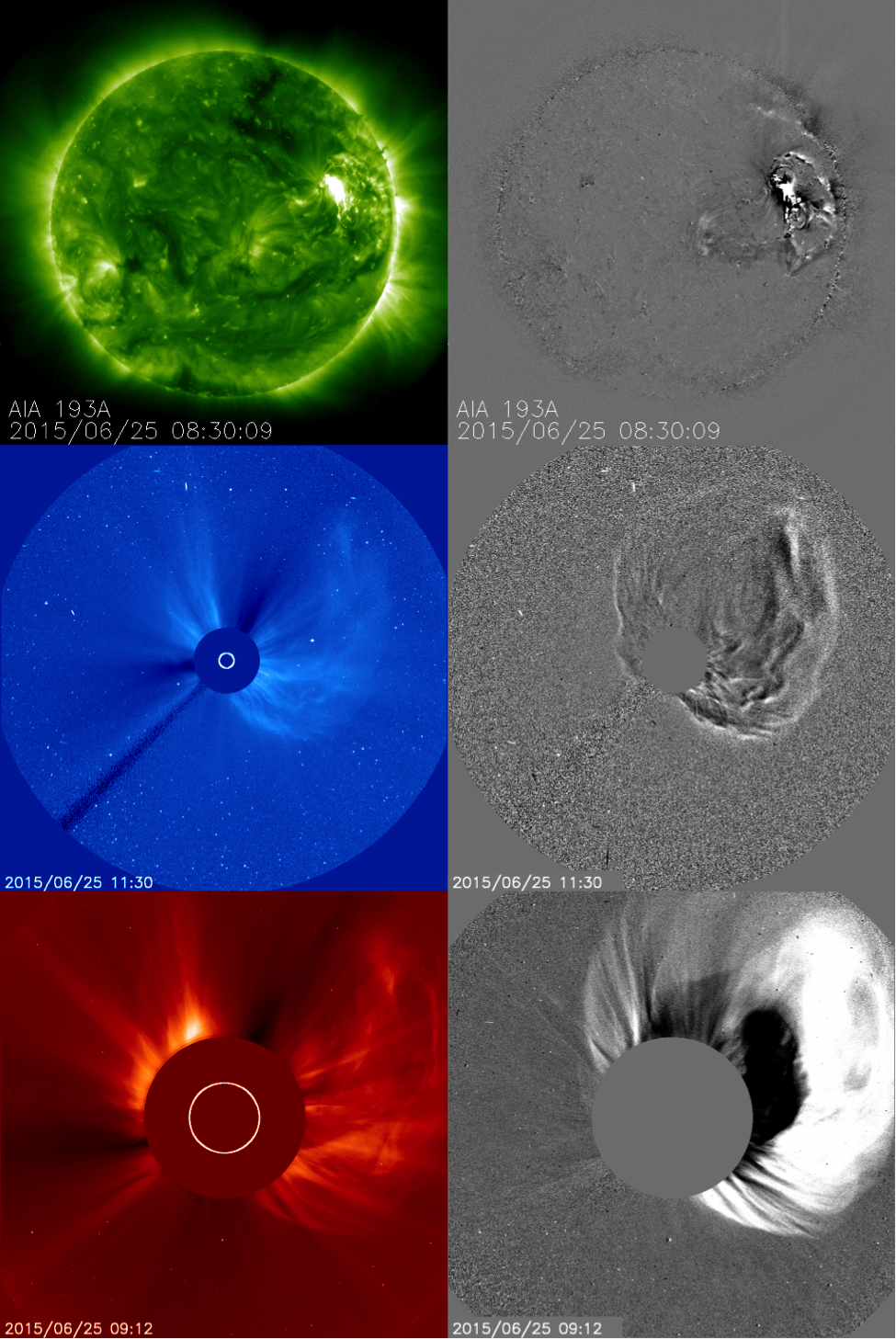
Proton levels were above the 10 pfu threshold at the beginning of the week and reached 1000 pfu as a consequence of the flare and CME from June 22. Then they decreased below the 10 pfu threshold on June 24, to go up again after the second M flare and related CME. They remained (slightly) above the threshold until June 27 when they went back to values under the 10 pfu threshold.

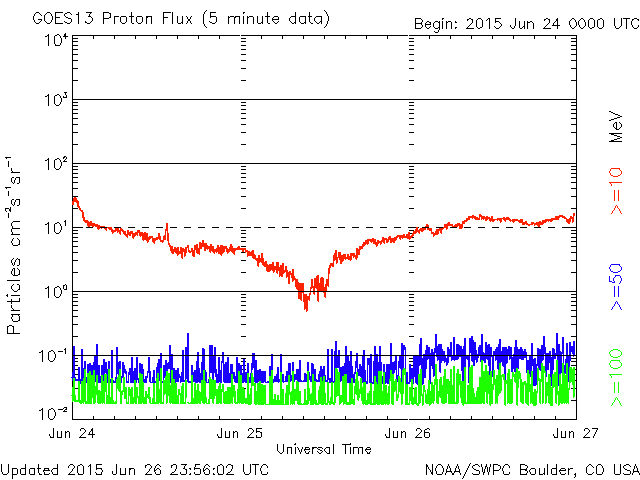
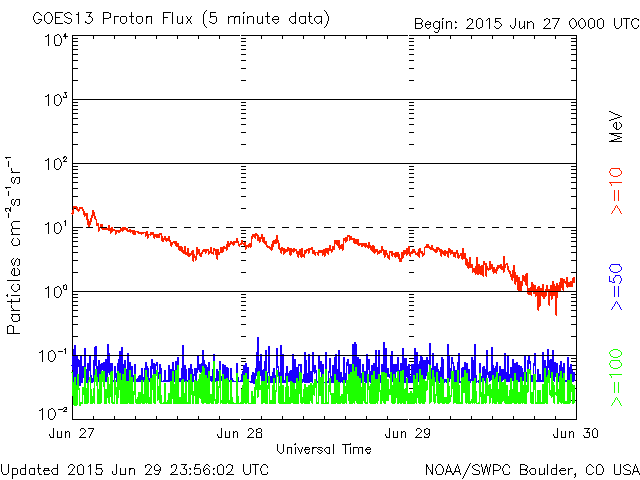
| DAY | BEGIN | MAX | END | LOC | XRAY | OP | 10CM | TYPE | Cat | NOAA |
| 22 | 1739 | 1823 | 1851 | N12W8 | M6.5 | 2B | 1000 | II/1 | 92 | 2371 |
| 25 | 0802 | 0816 | 0905 | N9W42 | M7.9 | 3B | 3800 | II/1IV/1 | 92 | 2371 |
| LOC: approximate heliographic location | TYPE: radio burst type |
| XRAY: X-ray flare class | Cat: Catania sunspot group number |
| OP: optical flare class | NOAA: NOAA active region number |
| 10CM: peak 10 cm radio flux |
A shock driven by an ICME was observed near Earth on June 22 at 18:01 UT. The magnetic structure was fast (~700 km/s), extended in time and space and carried a strong magnetic field. The corresponding CME had left the Sun on June 21. The solar wind speed and more parameters measured by SOHO/CELIAS/MTOF are plotted below.

Its passage resulted in a severe geomagnetic storm with K Dourbes and Kp reaching 8 in the night of June 22 and lasting until late on June 23.
The CME of June 22 arrived to the Earth on June 24 (at 12:56 UT), it caused a major storm according to Kp (Kp = 6) and a minor storm locally at Dourbes (K = 5), on June 25.
Finally, the CME from June 25 arrived to the Earth at 02:20 UT on June 27, it had high speeds (900 km/s) but the magnetic field was not particularly strong (15 nT) and mostly northwards directed, so only active geomagnetic conditions at Dourbes (K = 4) and unsettled at planetary levels (Kp = 3) were registered.
The solar wind parameters like speed and magnetic field strength measured by ACE are given in the graphs below.
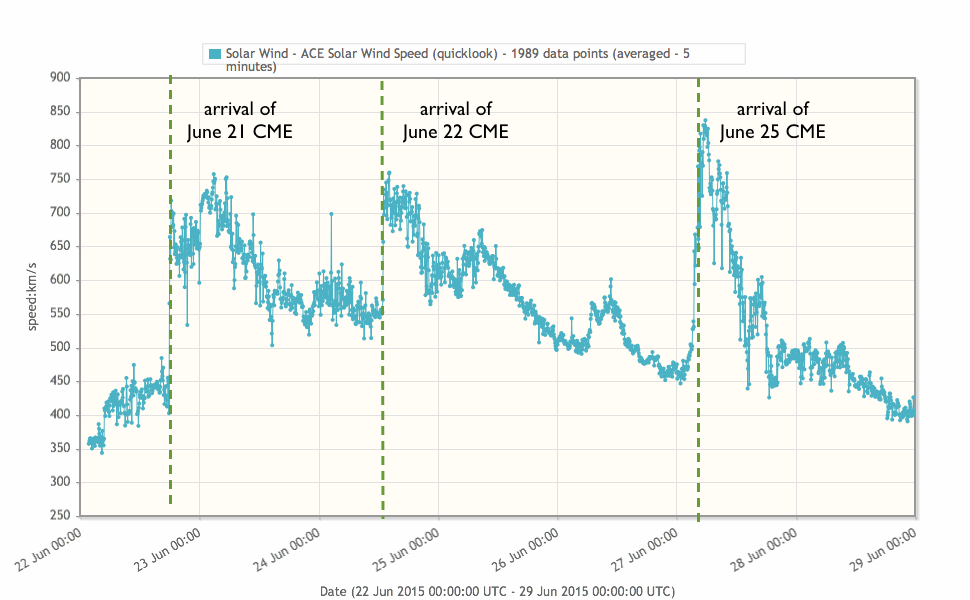

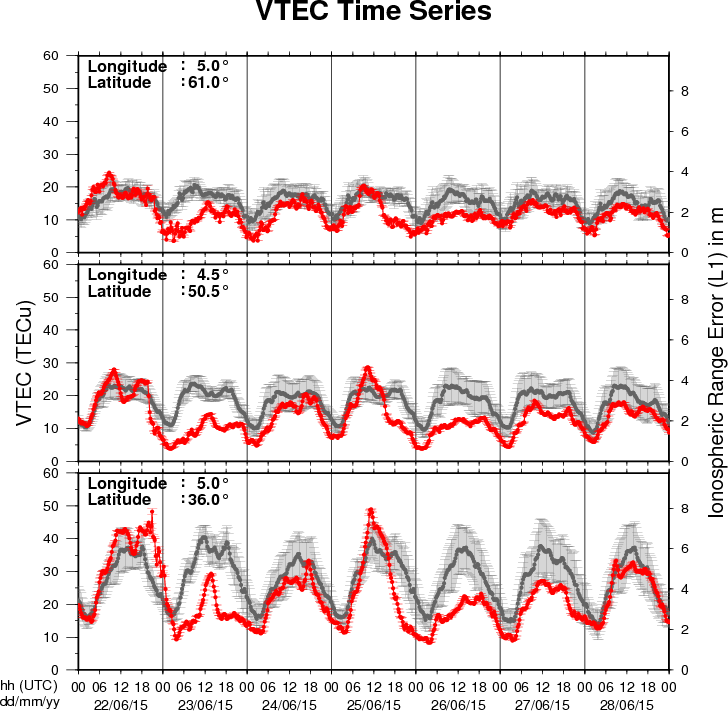
The figure shows the time evolution of the Vertical Total Electron Content (VTEC) (in red) during the last week at three locations:
a) in the northern part of Europe(N61°, 5°E)
b) above Brussels(N50.5°, 4.5°E)
c) in the southern part of Europe(N36°, 5°E)
This figure also shows (in grey) the normal ionospheric behaviour expected based on the median VTEC from the 15 previous days.
The VTEC is expressed in TECu (with TECu=10^16 electrons per square meter) and is directly related to the signal propagation delay due to the ionosphere (in figure: delay on GPS L1 frequency).
The Sun's radiation ionizes the Earth's upper atmosphere, the ionosphere, located from about 60km to 1000km above the Earth's surface.The ionization process in the ionosphere produces ions and free electrons. These electrons perturb the propagation of the GNSS (Global Navigation Satellite System) signals by inducing a so-called ionospheric delay.
See http://stce.be/newsletter/GNSS_final.pdf for some more explanations ; for detailed information, see http://gnss.be/ionosphere_tutorial.php
Start : 2015-07-05 - End : 2015-07-09
We would like to invite you to submit contributed abstracts to
the parallel session "The science of space weather: progressing our
understanding" at the 2015 UK National Astronomy Meeting from 5-9
July (http://nam2015.org). The abstract-submission deadline is 1
April 2015. Observers, modellers, and theoreticians are all
welcome. We also welcome participation from end users interested in
how the science of space weather is advancing.
The science of space weather: progressing our understanding
The goal of this session is to provide an opportunity to discuss
the scientific research that underpins space weather and how a new
generation of operational space weather measurements could best be
utilised to further progress our understanding. Specific topics are
likely to include 1) gaps in our understanding of space weather and
how to resolve them, 2) new space and ground-based data that are
needed, 3) new science that can be carried out with the operational
space weather measurements being planned today.
This session is motivated by the fact that the UK has a strong
heritage in the science of the coupled Sun-Earth system, from both
an observational and theoretical perspective. This research is
increasingly being applied to the area of space weather monitoring
and forecasting, a topic that is now nationally recognised as an
important natural hazard for the UK (highly ranked in the National
Risk Register) and the subsequent opening of the Met Office Space
Weather Operations Centre in 2014.
Up until now, both the research and the space weather monitoring
and forecasting have utilised mainly data from instrumentation
(both space- and ground-based) designed to answer pertinent
scientific questions, though some operational instruments (e.g. the
X-ray and particle detectors on NOAA's GOES spacecraft) are also
widely exploited for scientific use. However, there is now growing
interest in deploying more instruments, in space and on the ground,
designed to support operational space weather services. Such
operational measurements can facilitate new science, as
demonstrated by the extensive research use of GOES data, but it is
important that the limitations imposed by operational needs are
discussed.
Website: http://nam2015.org/
Start : 2015-07-13 - End : 2015-07-24
The CISM Summer School is intended to give students a
comprehensive immersion in the subject of space weather: what it
is, what it does, and what can be done about it. Space weather is
many things: beautiful when seen through the eyes of a sun-viewing
telescope, fascinating when studied for its alien worlds of
magnetic structures and phenomena, awesome when witnessed as a
solar eruption or auroral storm, and devastating to the users of
services it disrupts. Space weather links the Sun, the Earth, and
the space in between in a branching chain of consequences. Weather
systems on the Sun can spawn interplanetary storms of colossal size
and energy that envelop the whole planet in electrical hurricanes.
Such storms attack high-tech, complex, and expensive technological
systems that provide much of the infrastructure that allows modern
society to function.
Website:
https://www2.hao.ucar.edu/Events/2015-CISM-Summer-School
Start : 2015-07-21 - End : 2015-07-23
The conference will review past and recent achievements, as well
as future challenges in the field of solar coronal loop
physics.
Website:
http://www.damtp.cam.ac.uk/user/astro/cl7/index.html
Start : 2015-07-28 - End : 2015-08-04
Heliophysics is all of the science common to the field of the
Sun-Earth connections. This fast-developing field of research
covers many traditional sub-disciplines of space physics,
astrophysics, and climate studies. The NASA Living with a Star
program, with its focus on the basic science underlying all aspects
of space weather, acts as a catalyst to bring the many research
disciplines together to deepen our understanding of the system of
systems formed by the Sun-Earth connection.
Website:
http://www.heliophysics.ucar.edu/
Start : 2015-07-30 - End : 2015-08-06
The 34th International Cosmic Ray Conference (ICRC) will be held
from July 30 to August 6, 2015, in The Hague, The Netherlands. It
is an important and large conference in the field of Astroparticle
Physics. The ICRC covers: cosmic-ray physics, solar and
heliospheric physics, gamma-ray astronomy, neutrino astronomy, and
dark matter physics.
Website: http://icrc2015.nl
Start : 2015-08-31 - End : 2015-09-04
The purpose of this conference is to discuss the latest
questions and results in solar and stellar physics. Solar and
stellar seismology will be one particular focus but contributions
on all aspects of solar-stellar relations will be welcome. We aim
to establish links and synergies between the day- and night-time
fields of astrophysics.
Website:
http://www.iac.es/congreso/solarnet-3meeting/
Start : 2015-09-02 - End : 2015-09-04
The Workshop will address how the joint exploration of the
corona and inner heliosphere will lead to advances in our
understanding of coronal heating and solar wind acceleration, the
magnetic and plasma structure of the heliosphere, and the
acceleration of energetic particles at shocks and flares. The
workshop will inspire research that will make use of SO and SPP
observations within the context of the NASA Heliophysics
Observatory System and identify key areas for preparatory research.
Synergistic observations from other ground based and space based
assets will also be addressed.
Website:
http://www.solarprobeplus.org/2015/
Start : 2015-09-06 - End : 2015-09-13
The International Workshop and School on solar system plasma
turbulence, intermittency and multifractals (STORM 2015) focus on
the quantitative experimental, theoretical and numerical
investigation of turbulence, intermittency, fractal/multifractal
features, waves and coherent structures interaction, criticality
and non-linear cross-scale coupling. As widely documented by
in-situ satellite measurements and remote or ground-based
observations, turbulence, intermittency and dynamical complexity
are quite ubiquitous processes observed in the dynamics of solar,
planetary and interplanetary plasmas, as well as in the dynamical
evolution of proxies linked to magnetospheric and ionospheric
variability.
Unfolding the spatio-temporal structure of magnetic field and
plasma fluctuations from experimental observations and numerical
simulations provides further insight on the structure of plasma
turbulence and intermittency. On the theoretical side, the
understanding of such complex dynamical behavior cannot be simply
surmised from the basic fluid/kinetic equations, but instead
requires novel theoretical, experimental and data analysis
approaches. The workshop is a forum to present and discuss latest
results in these fields. The purpose of the school is to give to a
young audience of Graduate, Ph.D. students, and postdoc scientists,
which ideally represents the next generation of scholars in the
physics of space plasmas, an overall view of both theoretical and
data analysis tools apt to fully exploit unique and unprecedented
observations that will be provided by future upcoming mission like
Solar Orbiter and Solar Probe Plus.
Website:
http://www.spacescience.ro/conferences/storm2015/
Start : 2015-09-07 - End : 2015-09-11
The meeting will cover various aspects of solar physics and
space weather related processes. The special emphasis will be paid
to progress in data-driven simulations and high-resolution
spectro-polarimetry as powerful diagnostic techniques to unravel
information about magnetic fields in the photosphere and
chromosphere of the Sun.
Website:
http://ssg.group.shef.ac.uk/Conferences/Ukraine_UK_2015/index.html
Start : 2015-09-14 - End : 2015-09-18
This summer school will acquaint a generation of young
researchers (advanced master students, PhDs, and junior
postdoctoral researchers) to modern open-source software efforts
adapted to High Performance Computing platforms, with a deliberate
focus on hands-on sessions. In these sessions, participants will
work with three different open-source software packages, learn
about their typical applications and evaluate their performance
aspects on massively parallel systems.
Website:
http://www.fz-juelich.de/ias/jsc/EN/Expertise/Workshops/Conferences/CSAM-2015/_node.html
Start : 2015-09-14 - End : 2015-09-18
Hinode is a solar satellite funded jointly by JAXA, NASA, ESA
and STFC/UKSA that has entered its ninth year of operations. It has
had a major impact across many areas of solar physics and
facilitated many fundamental discoveries. These findings are
documented in over 850 papers in the refereed literature and
hundreds of papers in conference proceedings. With 96 refereed
publications in 2013 and more than 81 papers in 2014, Hinode has
remained scientifically highly productive. A non-exhaustive list
indicates over 100 students globally who are undertaking or have
completed PhDs using Hinode data. With the Solar Orbiter on the
horizon, there is a good chance that the two missions will operate
at the same time. The meeting will help the solar physics community
to maximise the science return from the Orbiter.
Website:
https://star.pst.qub.ac.uk/wiki/doku.php/public/hinode9/start
Start : 2015-09-14 - End : 2015-09-18
The aim of RADECS conferences is to provide an annual European
forum for the presentation and discussion of the latest advances in
the field of radiation effects on electronic and photonic
materials, devices, circuits, sensors, and systems. The scope of
the conference encompasses technological processes and design
techniques for producing radiation tolerant systems for space,
aeronautical or terrestrial applications, as well as relevant
methodologies for their characterization and qualification. The
conference features a technical program, an Industrial Exhibition,
and one day tutorial or "short course" on radiation effects. The
technical program includes oral and poster sessions and round
tables.
Website:
http://www.radecs2015.org/
Start : 2015-09-21 - End : 2015-09-24
On the occasion of the forthcoming retirement of Prof. Costas
Alissandrakis, we organize an international solar physics
conference as a tribute to his career. Speakers will address the
present state of knowledge of topics that include: The quiet Sun;
Coronal/chromospheric heating; Solar magnetic fields; Active
regions; Flares; Coronal mass ejections; and Shocks.
Website: http://solar15.uoi.gr/
Start : 2015-09-21 - End : 2015-09-26
A good understanding of solar-terrestrial processes is
fundamental to modelling the influence of solar variability on the
Earth's environment and climate. To capture all the physical
aspects of the solar wind-magnetosphere-ionosphere-atmosphere
interaction, and also the impact of solar variability on climate,
the Sun-Earth system has to be studied as a whole. The main purpose
of this school is to provide graduate, PhD students and also young
post-doc researchers with a global view of the main physical
processes by which solar variability affects the Earth's
environment. In addition, an overview of different data analysis
and methods for describing solar-terrestrial relations will be
given. The school will provide a mix of lectures and activities
requiring students participation.
Website:
http://www.cifs-isss.org/
Start : 2015-10-05 - End : 2015-10-09
This CSPM-2015 scientific meeting will cover various aspects of
solar dynamic and magnetic phenomena which are observed over the
entire electromagnetic spectrum: white-light, Hα, Ca II,
and radio from ground and in a variety of other wavelengths (white
light, UV and EUV, and X-rays) from space. Emphasis will also be
placed on instrumentation, observing techniques, and solar image
processing techniques, as well as theory and modelling through
detailed radiative transfer in increasingly realistic MHD models.
The long-term (cyclic) evolution of solar magnetism and its
consequence for the solar atmosphere, eruptive phenomena, solar
irradiation variations, and space weather, will be in focus. Here,
special attention will be devoted to the long-term observations
made in Coimbra and also to the results of the SPRING / SOLARNET
and SCOSTEP VarSITI studies. In particular, the weak solar activity
during the current solar maximum will be discussed. Finally, since
this meeting is organised around the 90th anniversary of performing
the first spectroheliographic observations in Coimbra, a session
will be specially dedicated to new solar instruments (both
ground-based and space-borne) that will give access to unexplored
solar atmospheric features and dynamic phenomena over the coming
years.
Website:
http://www.mat.uc.pt/~cspm2015/
Start : 2015-10-18 - End : 2015-10-24
The workshop aims to bring together experts in the field of
cosmic rays and solar energetic particles with an additional focus
on their propagation inside the heliosphere and their interaction
with the magnetosphere. The talks will present the most recent
results related to solar energetic particles (SEPs), solar
modulation, space radiation and related phenomena.
Website:
http://www.phys.hawaii.edu/ams02/pages/workshop.php
Start : 2015-10-19 - End : 2015-10-23
The workshop aims to gather experts from the various fields of
remote sensing observations of the inner heliosphere,
including white light, EUV, and radio observation,
together with modellers in order to tackle key outstanding science
and space weather operational issues, establish closer
working relations, and devise the best ways to move the field
forward as a whole. In addition, the science learned from remote
Âsensing observations is critical to improving our
capabilities of space weather forecasting. The workshop
aims to look at ways in which we can more easily and efficiently
share and access the various types of data between individual
groups and subÂcommunities and to officially launch the
IPS Common Data Format v1.0 (IPSCDFv1.0) now in use. It also aims
to allow investigations into ways in which we model the inner
heliosphere looking at the advantages and disadvantages of the
available modelling, updates on present and future
remoteÂsensing capabilities, and investigating further
the ways in which these data sets all complement each other and are
necessary to gain knowledge and understanding of the fundamental
physical processes that occur within the inner heliosphere. These
are critical processes that are key to both Heliophysics science as
well as to spaceÂweather operations and forecasting.
Website:
http://www.sciesmex.unam.mx/workshop2015/
Start : 2015-10-26 - End : 2015-10-29
In the tradition of the series of »Potsdam
Thinkshops«, we invite instrument specialists,
observers, modellers, and theorists to exchange ideas, to stimulate
discussion, to initiate future collaborations among participants,
and to attract new users of instruments by showcasing the
capabilities. The aim is to make progress towards a comprehensive
description of solar eruptive events effectively aggregating their
global properties as well as their highly dynamic fine
structure.
Website:
https://thinkshop.aip.de/12/cms/
Start : 2015-10-26 - End : 2015-10-30
The workshop is to improve the scientific understanding of the
origin and propagation of solar transients, and develop the
prediction capacity of these transients' arrival and potential
impact on the Earth. The workshop engages coordinated international
activities in observation, theory and modeling, and involves
scientists in both developed and developing countries, and provides
an online platform for educational opportunities for students.
Website:
http://cintli.geofisica.unam.mx/congreso/
Start : 2015-11-10 - End : 2015-11-13
Observations of the Sun and Earth from space have revolutionized
our view and understanding about impacts of solar variability and
anthropogenic forcing on Earth climate. For more than three solar
cycles since 1978, the total and spectral solar irradiance (TSI and
SSI) and global terrestrial atmosphere/surface have been observed
continuously, enabling unprecedented quality data for Sun-climate
studies. The primary objective of this symposium is to convene
climate scientists, solar physicists, and experimentalists together
for a better understanding how Earth climate system changes and
responds to solar variability.
Website:
http://lasp.colorado.edu/home/sorce/news-events/meetings/2015-sun-climate-symposium/
Start : 2015-11-23 - End : 2015-11-27
The European Space Weather Week (ESWW) is the European forum for
Space Weather users, forecasters, scientists and the involved
industries, as proven by the high attendance to the ESWW 11 in
November 2014.
The ESWW 12 will be held in Belgium in November, 23-27, 2015 and
its organisation has already started and is benefiting from the
experience and inputs from the past editions.
Website: http://stce.be/esww12/
Start : 2016-05-22 - End : 2016-05-27
Electric currents are fundamental to the structure and dynamics
of space plasmas, including our own near-Earth space environment
(also called "geospace"). This recognition is one of the great
achievements in space research, going back to the beginning of the
last century. With the current multi-spacecraft missions, such as
Cluster, THEMIS and Swarm, we have unprecedented opportunities to
unravel many of the intriguing puzzles about electric currents.
The conference will provide a forum in which various space
science communities can come together to discuss recent
achievements of observational, theoretical, and modelling studies.
The emphasis will be on cross-disciplinary science sessions.
Website:
http://chapman.agu.org/spacecurrents/general-informationabout-conference/
Start : 2016-07-30 - End : 2016-08-07
The 41st COSPAR Scientific Assembly will be held in Istanbul,
Turkey from 30 July - 7 August 2016. This Assembly is open to all
bona fide scientists.
Website:
https://www.cospar-assembly.org/
Start : 2016-10-09 - End : 2016-10-13
The scientific goal of this symposium is to discuss recent
results on the processes shaping the structure of the solar
atmosphere and driving plasma eruptions and explosive events.
Activity of the solar atmosphere entails numerous multi-scale
processes. State-of-the-art solar instrumentation is revealing the
dynamics of the Sun with unprecedented temporal and spatial
resolutions. Together with advanced numerical simulations these
investigations are making new steps in our understanding of the
complex dynamical structure of the solar atmosphere.
Major unsolved problems of astrophysics such as how the solar
corona is heated and how the solar wind and heliosphere are powered
have their roots in the origin of small-scale magnetic fields
constituting the Sun's 'magnetic carpet' in the
photosphere and appearing as 'magnetic canopy' in the
chromosphere.
Website:
http://www.iau.org/science/meetings/future/symposia/1160/